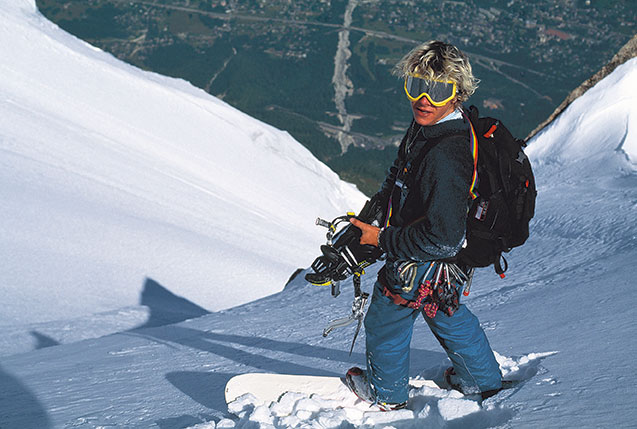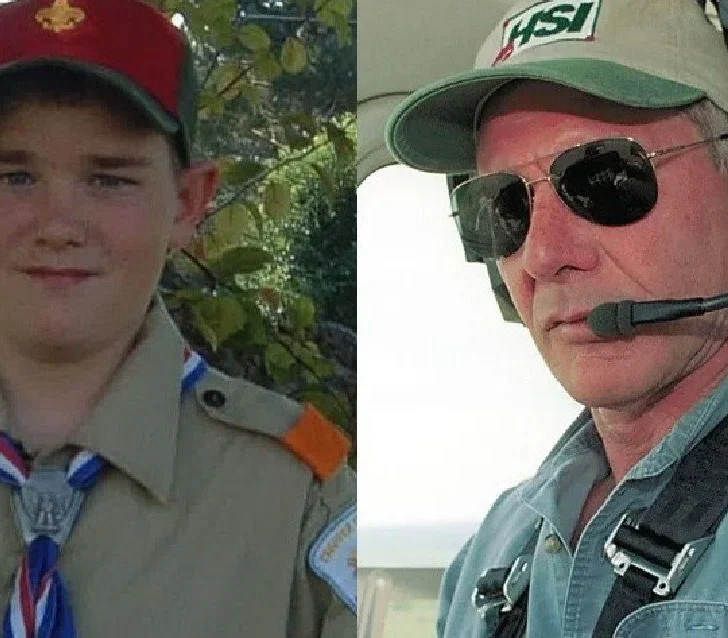Imagine being in subzero temperatures, standing on a frozen lake. A small hole has been cut in the ice you stand atop, perhaps no more than a few feet in width and length.
You jump, feet first, into the freezing water beneath the solid sheet of ice, submerging yourself into the −2 °C lake with just a tiny exit hole above you.


You have no safety gear, no oxygen tank, and no formal training in ice diving. You aim to dive in and withstand the strong current and harsh conditions before emerging from the hole.
Many of us would panic at the thought of being unable to find the hole in the ice after jumping in, fearing a terrifying death as we are trapped beneath the ice, mere feet from safety.
The freezing temperatures could cause our bodies to go into shock, rendering us immobile.
Then there’s the danger of hypothermia, which can cause confusion and distress and leave us unable to pull ourselves from the lake.
In fact, the idea is so panic-inducing that you may think nobody would carry out this act willingly.
However, the tradition of ice diving is a conventional way for devoted religious people in Russia to show their allegiance to God.
Although a minority of people carry out this potentially dangerous practice, it’s a widely accepted way to celebrate the Orthodox Epiphany.
The Epiphany takes place on January 19 each year in remembrance of the baptism of Jesus by John the Baptist, which, according to the Orthodox calendar, took place on this particular day.
Even Russian President Vladimir Putin immerses himself in an ice hole each year to mark the event.
Unlike other variations of ice diving carried out by trained professionals—such as in Norway and Canada, for instance—these individuals forego safety gear, leading to some devastating outcomes in recent years.
Some divers have fallen victim to the icy waters and have tragically drowned, unable to find the ice hole they jumped through to pull themselves from the water.
With their friends and family just feet above them on the impenetrable ice, these people had to endure a terrifying death as their loved ones were powerless to help.
So, what is ice diving, why is it carried out, and what leads to people unwittingly diving to their deaths?
The Tradition Of Ice Baths In Russia
The ice diving tradition in Russia began as the “Epiphany Ice Bath.” The age-old convention dates as far back as the 15th century.
Those who partake believe that if they submerge themselves in the freezing water each January, their souls will be cleansed, and they will maintain good health for the remainder of the year.
In 1901, Russian writer Apollon Korinfsky wrote of ice bathing, “They bathe to cleanse themselves of sinful filth in the blessed water.”
It’s estimated that more than 200,000 people brave the dive and jump in the ice holes in Moscow and surrounding areas yearly.
The tradition is also carried out in the notoriously cold temperatures of Siberia, which can plummet to −40 and −50°C.
Bear in mind that people who partake in this tradition aren’t trained to deal with freezing temperatures, nor do they train for the exercise before taking the plunge.
However, there are some unwritten “rules” of the ritual to help ensure the safety of those taking part.
Pregnant women, children under 12, and those with diabetes are forbidden from participating.
Ideally, when out in the freezing temperatures, participants ought to gradually remove their clothing, piece by piece, to allow their bodies to get used to the intense cold.
It wouldn’t take much for a person to get frostbite or hypothermia in such conditions, so care needs to be taken when acclimating to the harsh temperature.
Usually, people wear bathing shorts or a swimming costume to take the plunge, and it’s advised that drinking a spoonful of fish oil prior to diving will help the body retain as much heat as possible.
Some divers also apply cream to their bodies in the hopes that it will keep them warm.
Once immersed in the freezing water—for a minute or less, as advised—it’s paramount that a person’s head remains above the water.
If their head dunks into the icy water, their blood vessels may narrow so much that blood is restricted from reaching the brain.
After emerging from the water, a hot, sweet tea is recommended.
In many ways, an ice bath is a more controlled, safer practice than ice diving, which involves submerging one’s entire body into the biting, icy waters.
Each year, the Russian authorities cut the ice holes in selected frozen lakes and rivers in January and deploy medical professionals and rescue teams to the bathing spots.
They set up changing rooms, offer an array of food from stalls, and offer free tea for emerging divers. It’s a community event that even non-religious individuals attend to witness the traditional dive take place.
However, when these communal ice baths become unmonitored ice dives, the act becomes all the more dangerous.
When coupled with the lack of medical support, knowledge of the waters, and training, ice dives can become a deadly tradition for the unprepared.
Ice baths are practiced as a group, while many ice dives are carried out in desolate areas without direct access to aid if something goes wrong.
In recent years, two individuals who dared to plunge themselves into icy waters tragically perished.
A Russian woman was swept from the ice hole she jumped through, the current dragging her to her death.
A month later, a Ukrainian man drowned after jumping into choppy waters to complete an ice dive.
Their loved ones tragically witnessed the traumatizing events.
Tragic Ice Diving Accidents
In 2022, 40-year-old lawyer Anna Uskova decided to take the plunge to mark Orthodox Epiphany.
She, along with her husband and children, made their way to the Oredezh River in Russia on a dark, cold, freezing January night.
Anna’s dive was captured on video, as was her family’s subsequent panic and distress when the mother-of-two didn’t emerge from the water as expected.
The recording captures Anna standing on the edge of the rectangle hole cut from the thick ice surrounding her. She makes the sign of the cross, plugs her nose, and jumps feet first into the water.

She then disappears into the darkness of the river.
For a second or two, her family is silent in anticipation of her emerging from the ice hole. One of her children begins to panic and shouts out for his mother, after which Anna’s husband, Yury, races to the hole and jumps in.
It was too late.
The strong current had already swept Anna away. Unbeknownst to Anna and her family, the current was moving at a staggering rate of 10 feet a second when she jumped in.
Despite her strong swimming abilities, she was no match for the water.
The thick sheet of ice above her rendered her trapped in the river as the current dragged her further and further away from her one source of escape.
In the aftermath of the accident, the local authorities did their best to retrieve Anna’s body, even incorporating the use of underwater drones to find her. Neither the drones nor the experienced rescue team was able to find her.
Her son, once a strong and confident swimmer, stopped attending his swimming training after witnessing the traumatizing incident.
The unapproved dive was later the source of much debate in Russia.
Since ice dives, or ice baths, are commonly carried out as a community event, complete with adequate lighting, a medical team on hand, and an emergency rescue team, there are layers of safety for the diver. Such measures were not in place for Anna.
The fact that Anna jumped into an ice hole that was cut above a river with such a strong current was heavily critiqued also, with many labeling her death as preventable.
The momentum of her dive, coupled with the strong, fast current, was a tragic combination for Anna and her family.
To further add to the tragedy, there was an “official” ice hole cut nearby in a river with a much weaker current, complete with steps to help people in and out of the water. Sadly, Anna jumped into the more dangerous ice hole.
Disaster would strike again just a month later, on February 5, 2022.
A 38-year-old man, named only as Alexander, asked his wife to film him as he jumped into the frozen Chortomlyk River in the Dnipropetrovsk region of Ukraine. He would never emerge from the water.
Yet again, it was all caught on film.
The video begins with Alexander walking on the ice while a companion behind him cuts a hole in the ice with a chainsaw.
Once the rectangle is cut, Alexander poses for his wife, who is behind the camera, before standing in front of the ice hole. He makes the sign of the cross and jumps feet first into the river.

His wife waits a few seconds before realizing something is wrong. “Where is he?” she repeats, clearly distressed at the idea that the current had dragged her husband beneath the ice.
Tragically, this is exactly what happened.
The panicked woman asked her companions if she should call for help, to which one of them replied with an alarmed “Yes.”
As they waited for the emergency services, one of Alexander’s friends took an axe to the ice to create a bigger escape hole. Sadly, it would be too late.
Rescuers arrived on the scene and dived into the river. They couldn’t find Alexander initially, though the following day, his body was discovered 70 feet away from the shore. He had plunged 13 feet beneath the ice.
The spate of ice diving deaths caused the use of unapproved ice holes to be critiqued heavily.
Braving The Dangers Of Ice Diving
The dangers involved with ice dives are plentiful, though professional dives are often much more safety conscious than the ones carried out by untrained individuals.
For example, the threat of getting lost or stuck under the ice is high.
Professional divers who wear dry suits and are kitted with oxygen tanks also have a safety line that leads them back to the ice hole. Many untrained ice divers simply dive in their swimwear with no safety rope guiding them back to land.
Hypothermia is a big danger for divers, too, though professionals will have thermal layers to help them brave the icy waters.
Danger doesn’t just lurk beneath the ice, either: if too many people are standing near the ice hole, the surrounding ice can crack and break.
Naturally, this would prove hazardous for those standing on the ice, particularly if they are unprepared to be plunged into freezing water.
Slipping on the ice itself has proved perilous for many ice divers, professional or otherwise. As a result, those who carry out ice dives are recommended to wear sturdy shoes upon making their way to the ice hole.
Should a diver hit their head against the layer of ice on the surface as they jump into the hole, the possibility of drowning becomes all too real.
Despite the dangers it presents, the tradition of taking the plunge to celebrate the Orthodox Epiphany is a long-standing part of Russian history.
The significance of the spiritual practice means that regardless of the dangers, many brave individuals will still partake in the age-old tradition of ice diving every January.













Leave a comment